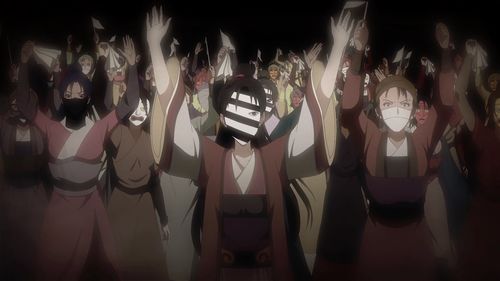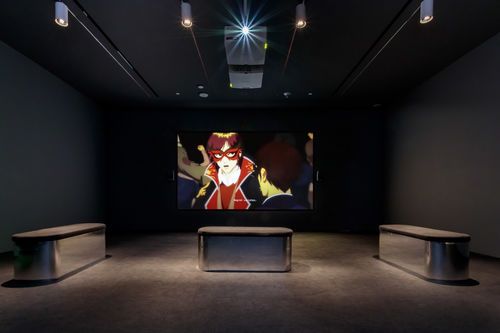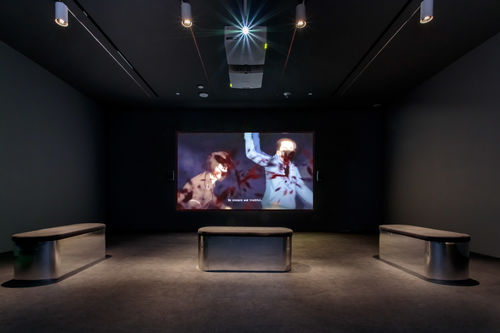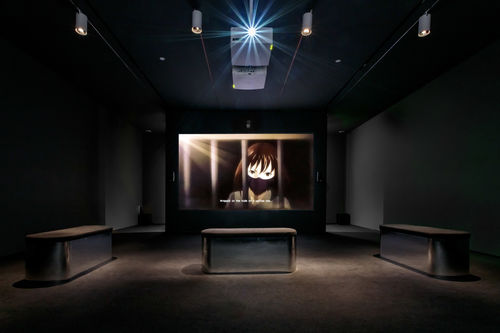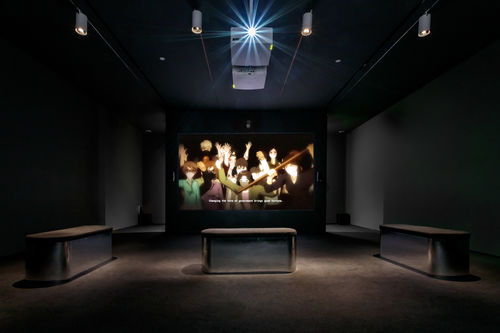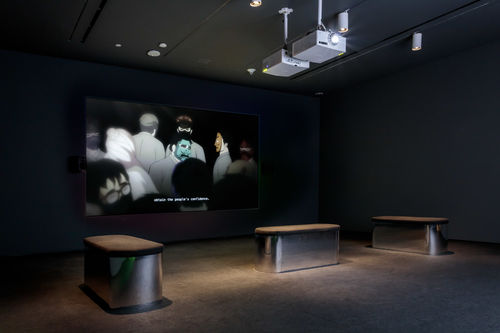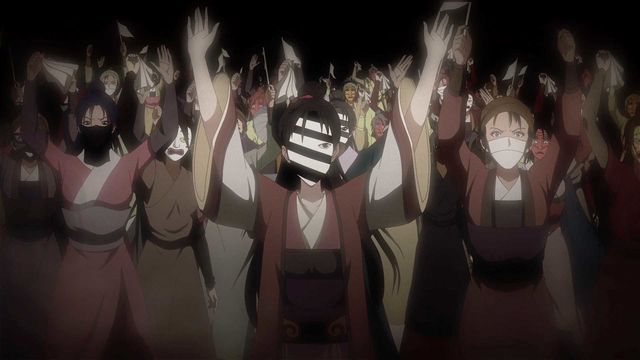
Hammer Projects: Ho Tzu Nyen
- – This is a past exhibition
The 49th Hexagram (2020) is a two-channel video and sound installation that explores the construction of cultural memory and political narrative surrounding the history of the Korean peninsula. Employing the services of an animation studio in Pyongyang, North Korea, Ho Tzu Nyen’s recent work reinterprets scenes of political uprising and mass demonstration as depicted in South Korean narrative film and television. The project aims to form a direct relationship between South Korea’s political history and the tensions that still define the country’s relationship with its northern counterpart. The result is, in the artist’s words, a “game of exquisite corpse across geopolitical barriers.” The video installation is complemented by an experimental soundtrack developed in collaboration with Korean artists and musicians Bek Hyunjin, Park Minhee, and Ryu Hankil. Offering two vocal renditions of texts from the forty-ninth hexagram of the I-Ching, an ancient Chinese divination manual, the installation’s soundtrack composites historical interpretation with translation to speak of revolution and renewal.
Hammer Projects: Ho Tzu Nyen is organized by Aram Moshayedi, Robert Soros Senior Curator, with Nicholas Barlow, curatorial assistant.
Biography
Ho Tzu Nyen (Singapore, b. 1976) earned a BA in creative arts from Victorian College of the Arts, University of Melbourne (2001), and an MA in Southeast Asian studies from the National University of Singapore (2007). He has had solo exhibitions at such venues as Toyota Municipal Museum of Art (2021); Yamaguchi Center for Arts and Media (2021); Edith-Russ-Haus for Media Art in Oldenburg (2019); Kunstverein, Hamburg (2018); Ming Contemporary Art Museum (McaM), Shanghai (2018); TPAM, Yokohama (2018); Asia Art Archive, Hong Kong (2017); Guggenheim Museum Bilbao, Spain (2015); Mori Art Museum, Tokyo (2012); and Artspace, Sydney (2011). He has also participated in group exhibitions at National Gallery, Singapore (2018); Haus der Kulturen der Welt, Berlin (2017); Solomon R. Guggenheim Museum, New York (2016); Queensland Art Gallery / Gallery of Modern Art (QAGOMA), Brisbane, Australia (2016); Times Museum, Guangzhou, China (2013); and Witte de With, Rotterdam (2012). He participated in the Gwangju Biennale, South Korea (2020, 2018); Sharjah Biennial 14, United Arab Emirates (2019); and the 54th Venice Biennale (2011), where he represented Singapore. His films have premiered at the Cannes Film Festival, Sundance Film Festival, and the 66th Venice International Film Festival.
Essay
By Nicholas Barlow
Kim Jong Il—the former ruler of the “hermit kingdom” of North Korea—loved Daffy Duck. Western media reports on his obsession with the Warner Bros. cartoon often accompany a slew of other peculiar claims: Kim loved cognac and spent more than half a million dollars annually on Hennessy. He loved Hollywood movies and owned more than twenty thousand films, his favorites being James Bond, Rambo, and anything Elizabeth Taylor.
Couched in qualifiers like allegedly and reportedly, these claims may well be apocryphal, as is true of almost everything relating to North Korea. Under the rule of Kim Jong Un, the third leader in a dynasty that has stretched almost seventy-five years, a tight hold over the media continues, with state-controlled television and highly censored internet. During the outbreak of COVID-19 in 2020, the country locked down even more aggressively, insulating itself from the rest of the world and blocking the flow of information across its borders.[i] Which is to say, North Korea is a black box—it operates in isolation, with its inner workings concealed from the world. Information that sneaks across its borders is filtered through rigid government censorship; information that escapes emerges profoundly corrupted.
To produce the two-channel video and sound installation The 49th Hexagram (2020–21), the Singapore-based artist Ho Tzu Nyen utilized this black box phenomenon as part of a creative strategy. The artist employed an animation studio in Pyongyang, North Korea, to render and reimagine historical scenes of political uprisings as depicted in popular South Korean films and television shows. The animators were given preliminary direction by the artist but were ultimately permitted to interpret the material according to their own discretion, under the unspoken influence of stringent North Korean government restrictions.
The 49th Hexagram is a work that embraces uncertainty, ambiguity, and chance. Ho Tzu Nyen’s relinquishing of control over the production process is very much the point of the work. By purposely plugging information into a black box system that will distort it, the artist formed an epistemological experiment that investigates how cultural memory and political narratives can be shaped and how representations of historical events are mediated, mythologized, and radically distorted.
The product of this process is the animated film that sits at the core of The 49th Hexagram. Projected on opposing screens, the film features crowds of masked figures confronting faceless police and military operatives. Submerged in a black void nonspace, the animated figures mass together, raising banners and fists in protest, as an ominous sound of roaring crowds loops. The figures are arrested, beaten, shot, and tear-gassed. We, the viewers, are given no explicit information within the videos regarding what is behind the conflict, what the protestors are fighting for, or whom they are fighting against. Nevertheless, these violent encounters, devoid of apparent historical or political references, hold an uncanny familiarity.
To begin his project, Ho Tzu Nyen researched a century of political and social demonstrations on the Korean Peninsula. The artist amassed an archive of historical photographs and film clips from more than forty popular South Korean movies and television series from the late 1950s to the late 2010s. The film and television images depict a wide variety of protest movements—the Tonghak Uprising of 1894; demonstrations against Japanese occupation from 1910 to 1945; and a number of protests against dictators, military coups, and American interference in the second half of the twentieth century. The artist emphasized the events of the May 18 Democratic Struggle of the early 1980s, a student-led uprising in Gwangju, South Korea, against military rule that resulted in the deaths of as many as two thousand protesters. This event in particular was significant to the artist, as its history has been clouded by misinformation and censorship from South Korean politicians. Even today it is unclear how many protesters were killed, and its initiating spark remains contested.[i]
Reviewing his archive of protest imagery, Ho Tzu Nyen became fascinated by the similar rhyming aspects of each event, such as protesters wearing work or school uniforms or the use of masks for protection against tear gas and identification. “These movements were referencing one another in a manner that was completely self-aware,” the artist has said of the material that informed the work. “They were strategic—learning from the successes and failures of what had happened before—but it was clear that they also referenced each other symbolically, for inspiration.”[i] Both in the actual events and in their filmic representations, archetypes emerged, establishing a historical and symbolic through line across a century of conflict. From film stills and other historical photographs, Ho Tzu Nyen constructed two storyboards, organizing them chronologically by the dates of the protests and grouping them by visual motifs, such as depictions of fire and water. Working through an intricate network of intermediaries, he gave the storyboards to the North Korean animation studio to illustrate.
North Korea has an extensive history of animation that predates the cinephile Kim Jong Il’s love of Daffy Duck. The most successful and longest-running animation studio in the country, SEK (Scientific Education Korea), has operated in Pyongyang since 1957. And though it produces chiefly propaganda and children’s educational cartoons for internal consumption, in 1985 SEK began subcontracting for animation projects from outside North Korea as a means to attract foreign capital. The brunt of its work for international clients is noncreative labor, producing in-between animation cels and digital frames for Italian and French children’s cartoons. Animators in origin countries create key frames for a scene, and SEK’s “in-betweeners” fill in gaps to create smooth motion. Traditionally this work is laborious and time-consuming, requiring an assembly line of workers. At its peak in the early 2000s, SEK employed more than fifteen hundred staff and worked on as many as sixty films per year, both domestic and foreign, making it one of the largest animation studios in the world at the time.[i]
In employing North Korean animators to interpret and reconfigure the images they produce, Ho Tzu Nyen subverted the customary use of the North Korean animation studios, offering some creative autonomy to animators who are often granted none. Though the animators were given written directions for how one scene or frame should transition to the next, they were given little to no context or background information about the content they were animating. Due to political sensitivities and strict government guidelines, the animators were unable to include any elements that directly reference Korean history or even to depict recognizably Korean features. Ho Tzu Nyen advised them to replace any elements deemed potentially problematic as they saw fit. This led to a further transformation of the source imagery, not just from film still to animation but also from a semblance of historical accuracy to heightened fantasy. The animators erased backgrounds to minimize recognizable locations and depicted figures in fantastic masks and costumes to hide any identifiable features, producing a surreal effect in which the figures are plunged into a timeless, placeless black void, with protesters resembling superheroes and the soldiers looking like robotic antagonists.
A primary focus for Ho Tzu Nyen over the last decade has been a quixotic attempt to understand what constitutes the unity of Southeast Asia, a diverse region not unified by a single religion, language, or political power. This subject is perhaps most present in the artist’s Critical Dictionary of Southeast Asia (2012–), an expansive project composed of twenty-six sections, organized by the letters of the English alphabet. Each section represents key terms, which function as organizing devices: “D for Decay,” “I for Identity / Inscription / Irrigation.” At the core of this project is a video presentation in which the artist has amassed a database of texts, music, images, and videos, all of which relate in some way to Southeast Asia. This seemingly disparate information is plugged into an algorithm in which footage, music, and narration loop in endless variation, constantly reconstructing the piece anew.
Similar to The Critical Dictionary, The 49th Hexagram attempts to apply structure to an overwhelming mass of information. Instead of utilizing a computer algorithm, however, the structuring strategy for The 49th Hexagram is based on the ancient Chinese divination text the I-Ching, a cornerstone of classical Chinese cosmology, which significantly influenced the classical cultures of Korea, Japan, and Vietnam. It is composed of sixty-four diagrams, or hexagrams, to be read and interpreted in countless ways. For the artist, “the I-Ching is a device—almost a philosophical toy—that can be used to interface with uncertainty: not in order to dispel or to control it, but rather to tap into it, and generate something from it.”[i] Specifically, the artist homed in on the forty-ninth hexagram, which features the first known use of the Chinese character for revolution and connotes the peeling of skin and molting of animals, emphasizing transformation and transmutation. This “non-European” understanding of revolution, as the artist notes, became an important inspiration for his approach to a complicated history of social uprisings in the Korean Peninsula in The 49th Hexagram. [ii]
Accompanying the two-channel video work are two vocal renditions and interpretations of the forty-ninth hexagram, as sung by the Korean artists and musicians Bek Hyunjin and Park Minhee, one in a traditional Korean gagok vocal style and one in a more contemporary interpretation. These vocal tracks were then subjected to the “digital occult” processes of the musician Ryu Hankil, who distorted and manipulated each isolated track. As we watch the North Korean animators’ interpretation of South Korean filmic renditions of political unrest, the lines and interpretations from the forty-ninth hexagram frame the action.
The composer John Cage is perhaps the most famous Western artist to utilize the I-Ching as a structuring device. To produce his Music of Changes (1951), Cage employed the oracle texts to select the notes, pitch, duration, and tempo of his composition, forming what he labeled indeterminate music. But for The 49th Hexagram, Ho Tzu Nyen took inspiration from a work by another major post–World War II composer, Iannis Xenakis’s Evryali (1973). This composition for solo piano includes numerous passages that cannot not physically be played, as they ask the player to attempt too many notes at one time, too quickly. The performer is forced to make reductions and edits to the piece in order even to attempt it. These alterations reflect the decisions and capacity of the person playing Xenakis’s composition.[i] In a similar fashion, Ho Tzu Nyen requested that animators attempt to follow his storyboard, knowing that they could not do so accurately, and then showcased what they chose to remove and reinterpret.
To produce The 49th Hexagram, Ho Tzu Nyen adopted a strategy that embraced uncertainty. He began work on the project in 2019. As 2020 arrived, a strange mirroring emerged: like Ho Tzu Nyen’s figures, people around the globe began wearing masks. As his animators reinterpreted images of protest, a global protest movement emerged. The spectacle of crowds at political protests shielding their faces became commonplace and familiar. Analyzing the rhyming nature of the past, Ho Tzu Nyen taps into the uncertainty of the present.
Notes
- Human Rights Watch, world report, 2021 https://www.hrw.org/world-report/2021/country-chapters/north-korea.
- George Katsiaficas, Asia’s Unknown Uprisings, vol. 1, South Korean Social Movements in the 20th Century (Oakland, CA: PM Press, 2012), 489.
- Sunjung Kim and Ho Tzu Nyen, Ho Tzu Nyen, ed. Won Moon (Gwangju, South Korea: Gwangju Biennale Foundation, 2021), 18.
- “Axis of Animation,” Forbes, March 3, 2003, https://www.forbes.com/global/2003/0303/014/.
- Kim and Ho Tzu Nyen, Ho Tzu Nyen, 76.
- Ho Tzu Nyen, video conversation with the author, August 27, 2020.
-
Peter Hill, “Xenakis and the Performer,” Tempo, no. 112 (March 1975): 17–22.
Hammer Projects are single-gallery exhibitions highlighting the work of contemporary artists from around the globe, often presenting new work at a pivotal moment of an artist’s development. Ongoing since 1999, Hammer Projects is a signature series within the Hammer’s exhibition program.
Hammer Projects is presented in memory of Tom Slaughter and with support from the Horace W. Goldsmith Foundation. Lead funding is provided by the Hammer Collective. Generous support is also provided by Susan Bay Nimoy and Leonard Nimoy, with additional support from the Los Angeles Board of Supervisors through the Los Angeles County Arts Commission.
Hammer Projects: Ho Tzu Nyen is made possible, in part, by Alwyn Chong
The 49th Hexagram was commissioned by the Gwangju Biennale Foundation with support from the National Arts Council, Singapore; Edouard Malingue Gallery; and the Hammer Museum.



